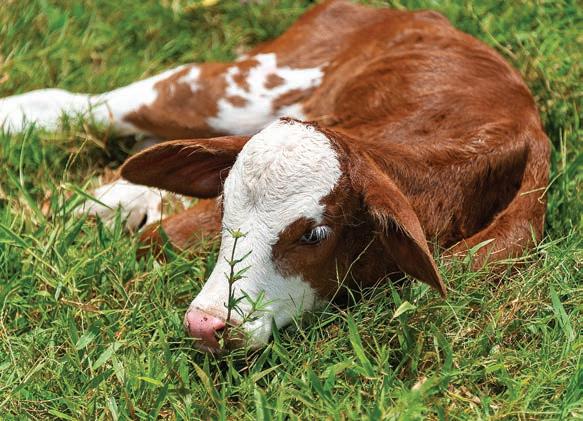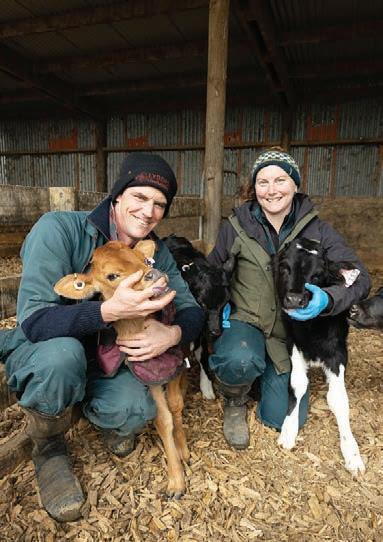
5 minute read
World
Focus on immunity-led disease management
CALF scours and pneumonia among youngstock in the beef suckler herd continues to be a major gripe for UK beef producers.
More than half of over 140 respondents to MSD Animal Health’s most recent National Youngstock Survey said they had experienced a problem; about 70% claiming to have had a calf scour issue and 60% having seen signs of pneumonia in their youngstock.
In addition, more than 35% of these producers also said that they had suffered beef calf mortalities as a result of these diseases.
MSD Animal Health survey coordinator Robert Simpson said: “It is perhaps not surprising then that improving farm biosecurity and disease prevention were high up on beef farmers’ priority lists
Advice on treating calves
• Use an antibiotic that targets the bacteria causing pasteurella and mycoplasma – speak to your vet to ensure you pick the right one. • Administer pain relief. • Keep calves drinking milk: One of the biggest failures often seen in the treatment of sick calves is removing or reducing the amount of milk fed to animals. This reduces energy and the calf will lose weight and become weaker. • Calves with pneumonia usually still want to drink/eat. It is not recommended to tube feed milk to calves older than 10 days as the milk could get into the rumen and cause digestive problems. • If calves won’t drink (this is often the case with calves that have diarrhoea) then consider tubing them small amounts (1 litre a day). when asked about what they were looking to improve”.
“Indeed, intent to take action in this area was second only to improving stocking density and rearing facilities in everybody’s top 10 wish list.
“Interestingly, similarly to dairy farmers, beef producers typically rated their youngstock rearing practices at more than seven out of 10, with more than 70% feeling they were giving enough attention to youngstock.
“However, many beef units are not monitoring calf growth rates, which would inevitably highlight room for improvement on some units.”
With scour said to be the most common cause of disease and death in young beef calves during the pre-weaning period, management of the disease PNEUMONIA is a respiratory disease that causes inflammation of the lungs. An infection in preweaned calves can reduce milk production later in life by 10-15% depending on the severity.
But if you catch it early – in the first two to three days – calves are much more likely to recover fully.
Therefore, knowing the symptoms is key.
There are six main signs calves with pneumonia will exhibit. If a calf has three of these you should treat it immediately.
Director of technical services at breeding company World Wide Sires Dr Scott Abbott explained the main signs to look out for. 1. Temperature: Take the rectal temperature. Higher than 39.5C indicates the calf may be sick. 2. Nasal discharge: Look for a is one of the main reasons for antibiotic overuse, according to the Responsible Use of Medicines in Agriculture Alliance, something, Simpson says, the industry is striving hard to change.
“Infectious scours can be managed effectively in suckler calves by sound hygiene practices and pre-calving dam vaccination,” he said.
“Suckled beef calves then gain immunity-led scour protection by drinking enough of this fortified colostrum from their mothers early in life.
“However, in our sample, only 30% were practising dam vaccination to control calf scours.” According to survey findings, 63% of beef farmer respondents reported calves gaining their colostrum solely from natural suckling. small amount of cloudy discharge up to excessive mucus discharge. 3. Coughing and increased respiration rate: Pinch the calf’s throat gently. If it starts coughing it’s a sign it has irritation. Other symptoms to look out for are repeated coughing in calves with
MORTALITY RATE: From the survey, 35% of beef farmer respondents reported that they had suffered mortalities as a result of calf scours and pneumonia.
“It is more unusual for beef producers to test dam colostrum quality, but is well worth doing if you want to improve your immunity-led disease prevention plan,” Simpson said.
“Only 7% of the beef farmers we surveyed were testing colostrum quality, whereas in our dairy farmer sample 25% of respondents said that they always did.”
Adding pneumonia is another disease area where the control
EARLY DETECTION: Knowing the symptoms of catching it early.
more severe symptoms, and laboured breathing. 4. Slow feed intake: Calves with pneumonia usually keep eating and drinking, but they will have a slower intake and will remain standing after they have eaten. This is because they feel focus has previously often been treatment with antibiotics.
“This disease also leaves an unwanted legacy even in calves that do recover, with depressions in growth rates,” he said.
Indeed, a pneumonia challenge in beef cattle has been shown to reduce gain by 202g per day from birth through to slaughter. Consequently, immunity-led disease prevention has to be the way forward.”
Six signs of pneumonia in calves

pneumonia is key to
UK Farmers Guardian
uncomfortable due to feeding increasing the amount of pressure on their already-swollen lungs. 5. Eye discharge: This can be a small amount of discharge near the tear duct, up to heavy discharge surrounding the eye and which has formed crusts. 6. Ears: In clinical cases calves’ ears will sag and they will also flick their ears. This is a sign they have mycoplasma which causes fluid on the ear.
In very severe cases it can cause swelling of the forehead due to the immune glands being enlarged.
If calves have these symptoms, treat immediately without diagnosing another two signs using an anti-inflammatory and antibiotic.
UK Farmers Weekly
KEEP AN EYE OUT
The latest Dairy Farmer hits letterboxes on August 31
Our OnFarmStory this month features Waikato farmer Bart van de Ven who runs YouTube channel Farming with a Laugh aimed at educating and informing people about farming.
We also talk with Bay of Plenty farmer Alan Law who has made the switch to biological farming. This month we showcase different bull breeds to help farmers make the right purchasing decisions for their herd.

September 2020
1
Farming through the lens Biological farming gets results New head of AgResearch

2460DF-12x7 Farming with a laugh A Waikato farmer is giving people a laugh with his informative yet funny farming videos








